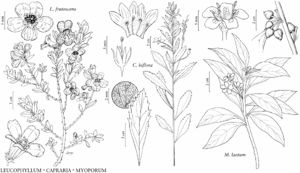Capraria
Sp. Pl. 2: 628. 1753.
| Taxon | Illustrator ⠉ | |
|---|---|---|
 | Leucophyllum frutescens Capraria biflora Myoporum laetum | Linny Heagy Linny Heagy Barbara Alongi |
Subshrubs; stolons absent, taproot woody. Stems erect, glabrous or glabrate to hirsute [densely glandular-pubescent]. Leaves deciduous, mostly cauline, alternate; stipules absent; petiole absent; blade not fleshy, not leathery, margins serrate distally, surfaces with punctate glands and internal secretory oil cavities. Inflorescences axillary, racemes; bracts absent. Pedicels present; bracteoles absent. Flowers bisexual; sepals 5, ± distinct, lanceolate, calyx radially symmetric, rotate; petals [4] 5, corolla white, sometimes with scattered purple spots inside, radially or bilaterally symmetric, rotate or tubular-funnelform, abaxial lobes 3, adaxial 2; stamens 4 or 5, adnate to base of corolla-tube, didynamous or equal, filaments glabrous, staminode 0; ovary 2-locular, placentation axile; stigma ellipsoid [reniform]. Fruits capsules, elliptic, dehiscence loculicidal. Seeds 90–120, brown, ovoid, wings absent. x = 14 or 15.
Distribution
Introduced; Mexico, West Indies, Central America, South America, Pacific Islands, also in Africa (Cape Verde Islands), also in Africa (Ghana), Indian Ocean Islands (Mauritius)
Discussion
Species 4 (2 in the flora).
Capraria is unique in Scrophulariaceae in having alternate leaves with surfaces with punctate glands and with internal oil-secreting cavities.
A molecular study by E. Gándara and V. Sosa (2013) showed that, depending on how Leucophyllum is defined, Capraria may either be considered nested within a broadly defined Leucophyllum or retained as a separate genus, as treated here.
Selected References
Lower Taxa
Key
| 1 | Stems and leaf blades hirsute to glabrate or glabrous; leaf blades spatulate; flowers bilaterally symmetric, 10–13 mm; corollas white with scattered purple spots inside, tubular-funnelform, villous inside; stamens 4(or 5), didynamous; styles included. | Capraria biflora |
| 1 | Stems and leaf blades glabrous; leaf blades lanceolate; flowers radially symmetric, 8–10 mm; corollas white, rotate, glabrous; stamens 5, equal; styles exserted. | Capraria mexicana |